Bavarian Cream Donuts are fried, fluffy donuts filled with the most luxurious Bavarian cream filling and rolled in sugar.
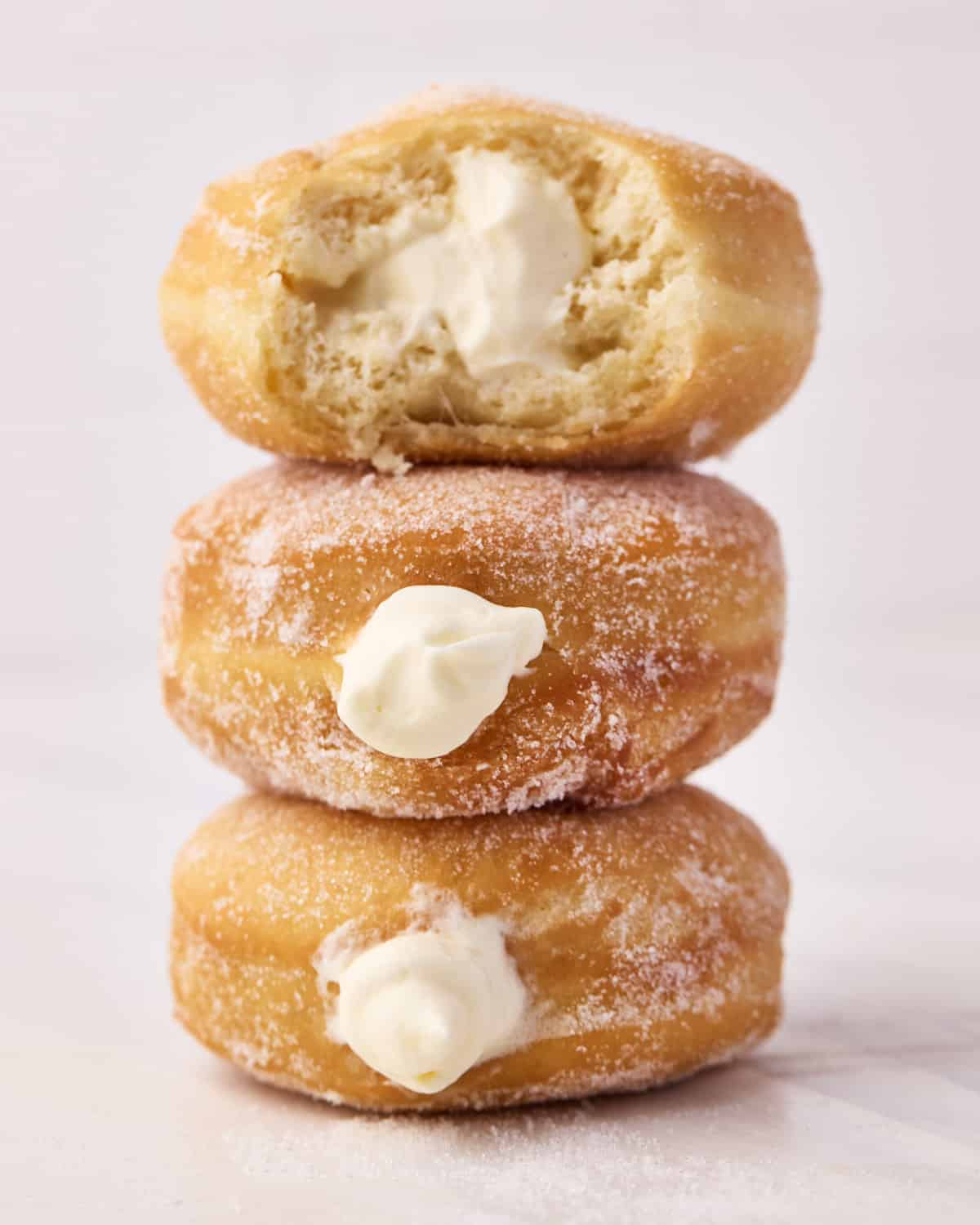
I avoided making homemade donuts for years because the process felt intimidating - but after plenty of experimenting, I'm sharing all the tips and tricks I wish I'd known from the start, so you can confidently make perfect donuts at home.
This Bavarian Cream Donut recipe guides you through every step, from preparing the dough and letting it rise to frying like a pro and filling each donut with a rich, silky cream. You'll never want to buy a store-bought donut again after tasting what you can create in your own kitchen!
Jump to:
Why You'll Love this Cream Filled Donut Recipe
- Homemade Bavarian cream donuts are far better than store-bought
- The cream filling is silky smooth and so delicious
- The donut dough and filling can be made the day before
Bavarian Cream Donut Ingredients
This Bavarian cream doughnut recipe actually uses very basic ingredients. The donuts and the filling use a lot of the same ingredients so you won't have a crazy long shopping list!
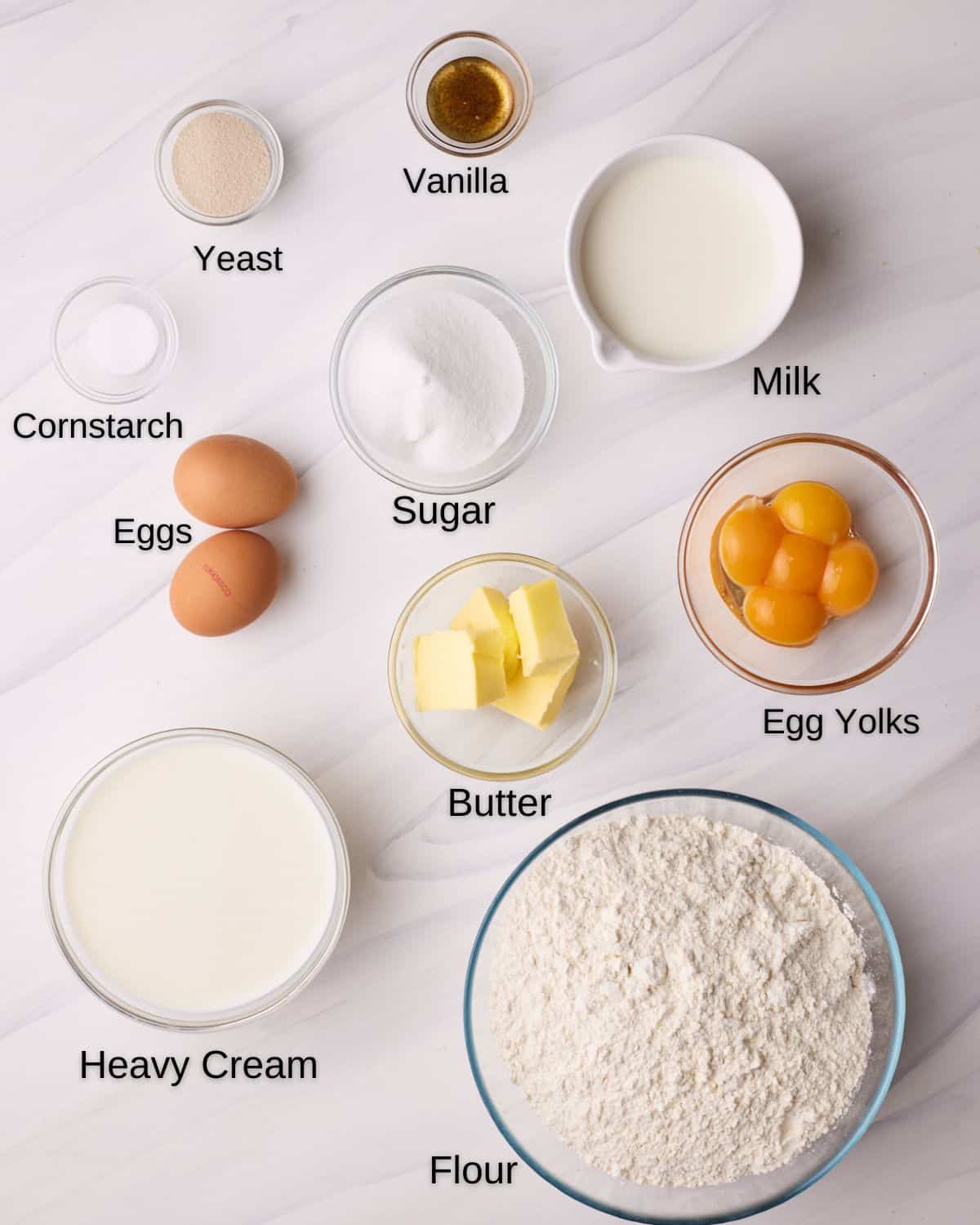
- Flour - All-purpose flour gives the best structure for donuts.
- Sugar - Regular white sugar, preferably superfine sugar (caster sugar)
- Yeast - You can use active dry yeast or instant yeast for this recipe
- Milk - You definitely want to use whole milk for the donuts and the filling
- Eggs - We need whole eggs for the donuts and egg yolks for the pastry cream. Use large eggs.
- Butter - I actually like to use salted butter for this recipe, but if you have unsalted butter just add a pinch of salt to the donut dough and the filling.
- Cornstarch - This helps to thicken up the donut filling.
- Vanilla - I like to use vanilla bean paste but vanilla extract will work fine as well.
- Heavy Cream - Make sure you use heavy cream or heavy whipping cream. It must have at least 35% fat.
- Oil - For frying the donuts you'll need a good amount of vegetable oil (or other flavorless oil like canola oil or sunflower oil). You need enough to make the oil at least 2-3 inches deep in your pan.
See the recipe card for quantities and the full recipe.
Equipment
- Stand Mixer - You could knead these donuts by hand but it will take a lot longer and can be tiring.
- Dough Hook Attachment - for kneading the dough
- Whisk Attachment - for whipping the cream
- Large Bowl - big enough for the dough to double in size in.
- Rolling Pin
- Cookie Cutter - About 2 ½ to 3 inches wide.
- Baking Sheet
- Medium Saucepan - should be deep enough to comfortably hold 3 inches of oil and still have plenty of space at the top.
- Frying Spoon - some kind of slotted spoon made of metal so it is heatproof
- Thermometer - Make sure it is a candy thermometer or a thermometer that can withstand high temperatures
- Wire Racks - I found I needed two wire racks to fit all my donuts on after frying.
- Whisk - For making the pastry cream
- Rubber Spatula - for folding the whipped cream into the pastry cream.
How to Make Bavarian Cream Donuts
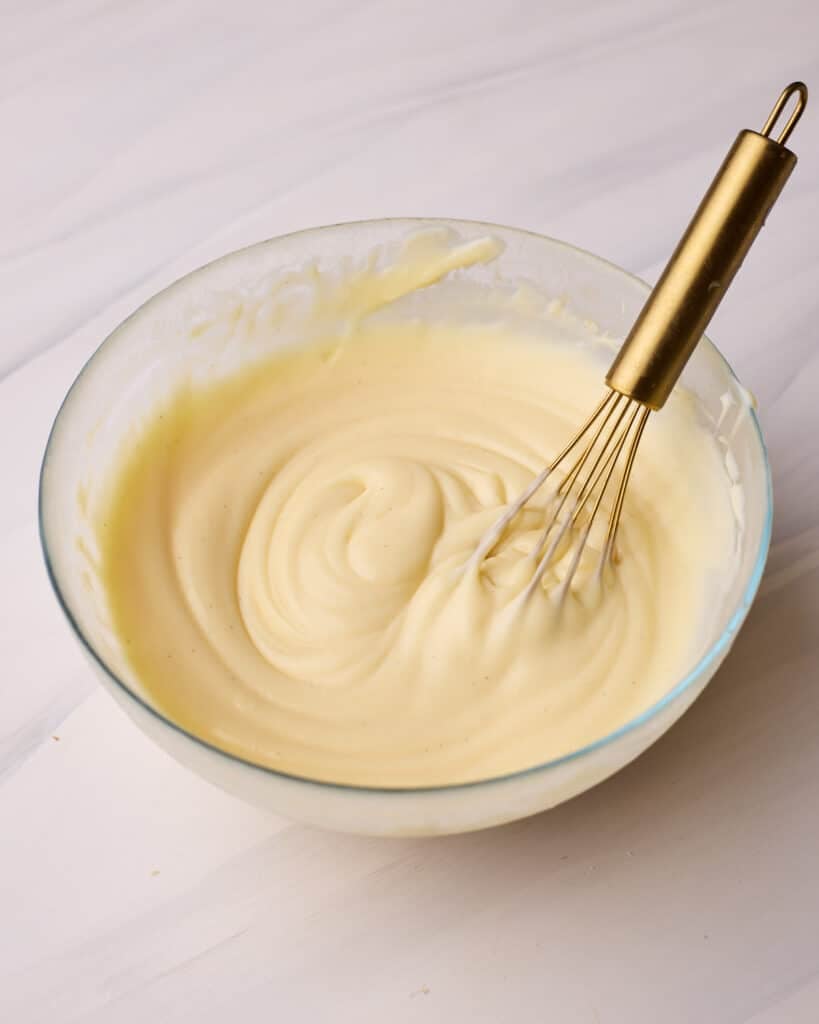
Make Pastry Cream
Make the pastry cream at least 2 hours in advance. It's best when made the day before so the flavors have a chance to develop.
For in-depth instruction and step-by-step process shots, see my vanilla pastry cream recipe post.
(For these donuts we only use a half batch of that recipe, which is reflected in the recipe card below).
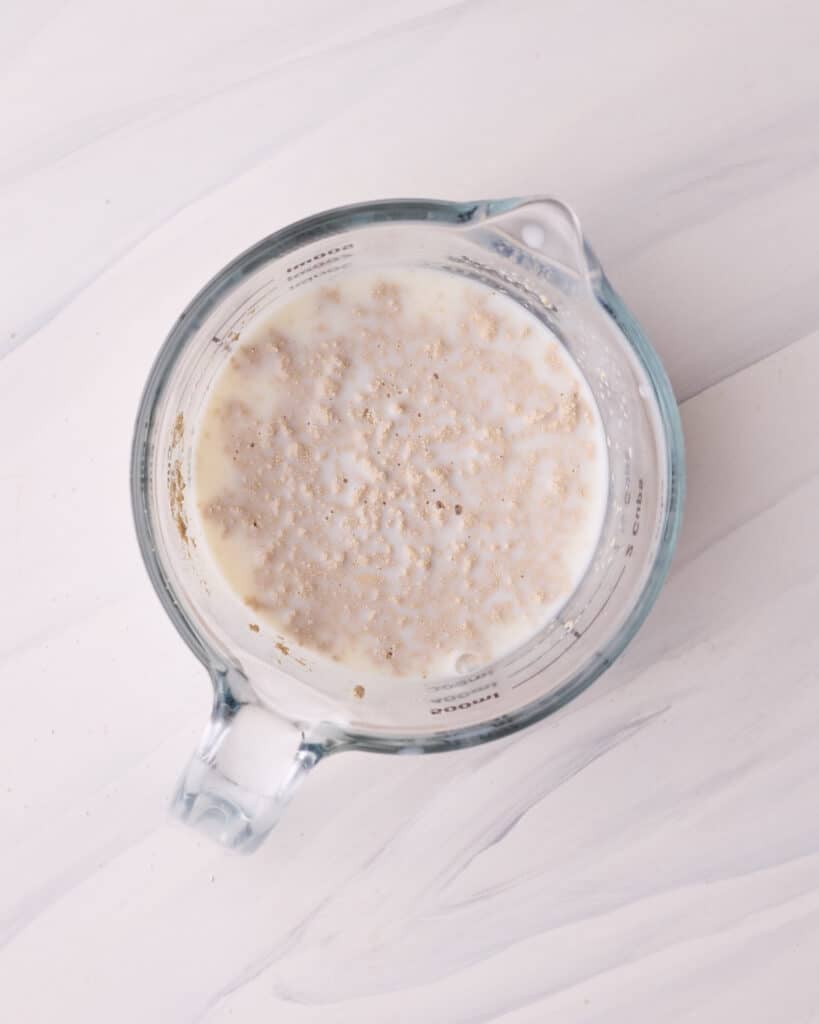
Activate Yeast
Warm the milk to roughly body temperature, then mix the dry yeast and a tablespoon of the sugar into the warm milk and let sit for 5-10 minutes to get frothy.
If you are using instant dry yeast you can skip this step.
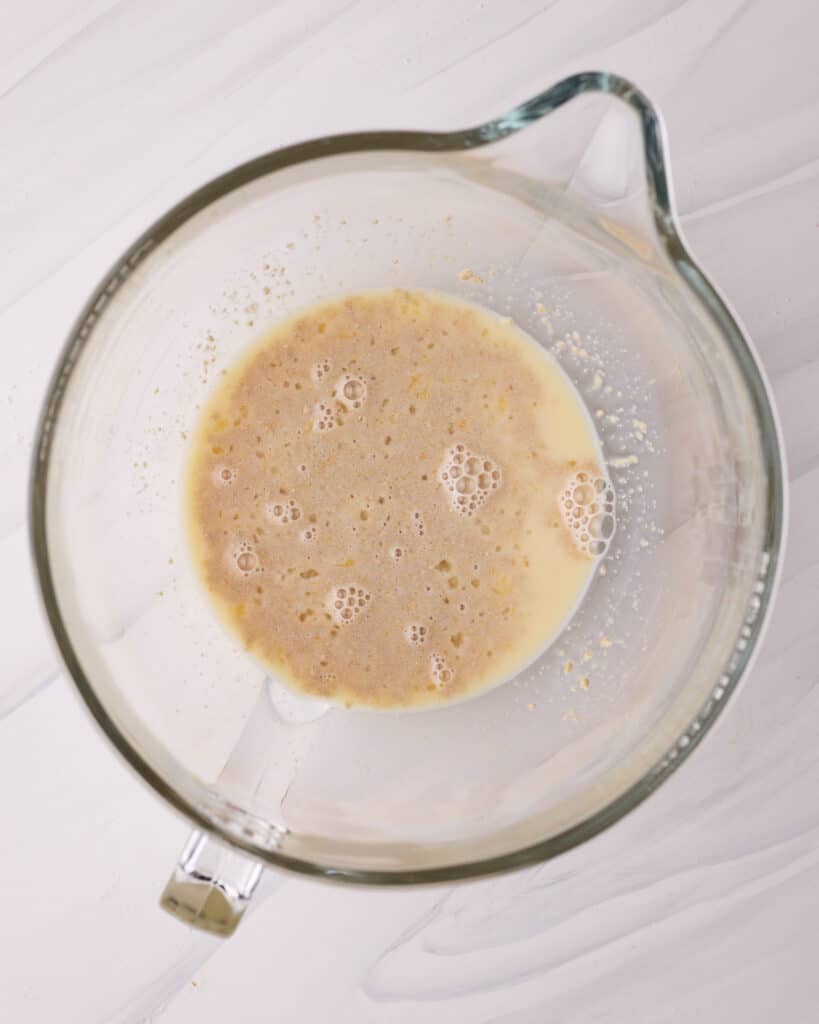
Wet Ingredients
In the bowl of a stand mixer with a dough hook attachment, add the eggs, sugar, and salt.
Once the yeast has activated, add the milk/yeast mixture to this bowl and mix everything together to combine.
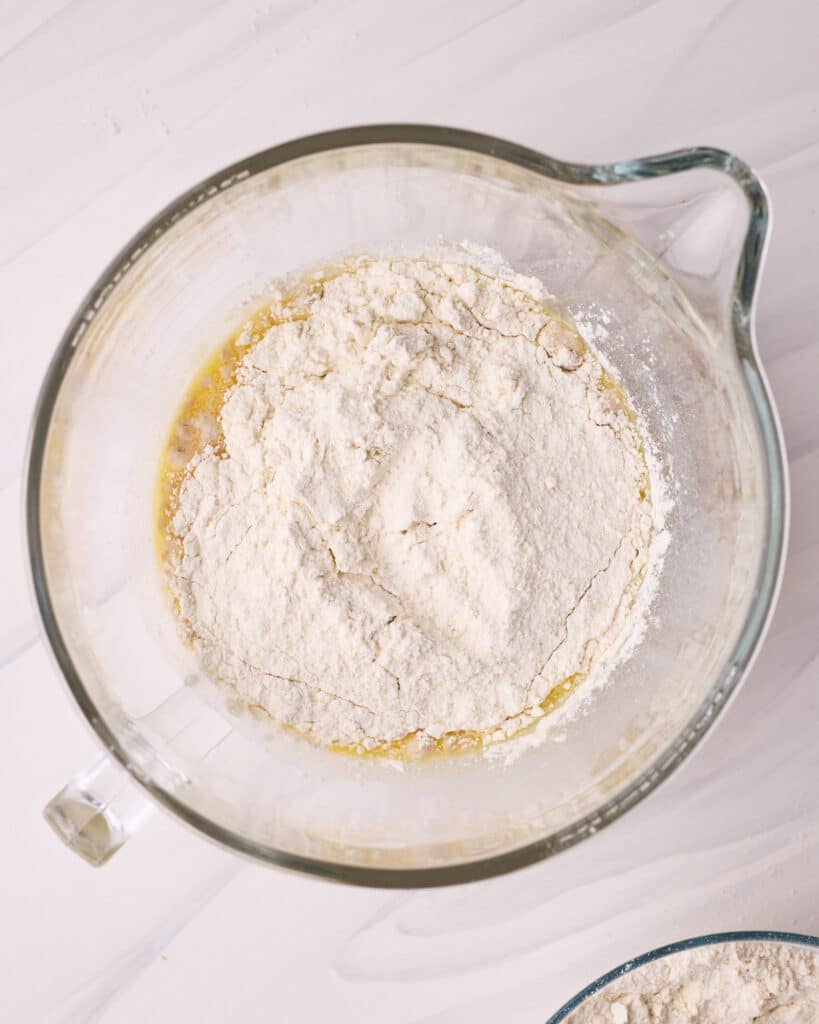
Dry Ingredients
Add the flour to the mixing bowl and turn the mixer on low speed for a minute to allow the flour to incorporate.
Drizzle in the melted butter gradually, while still mixing on low speed.
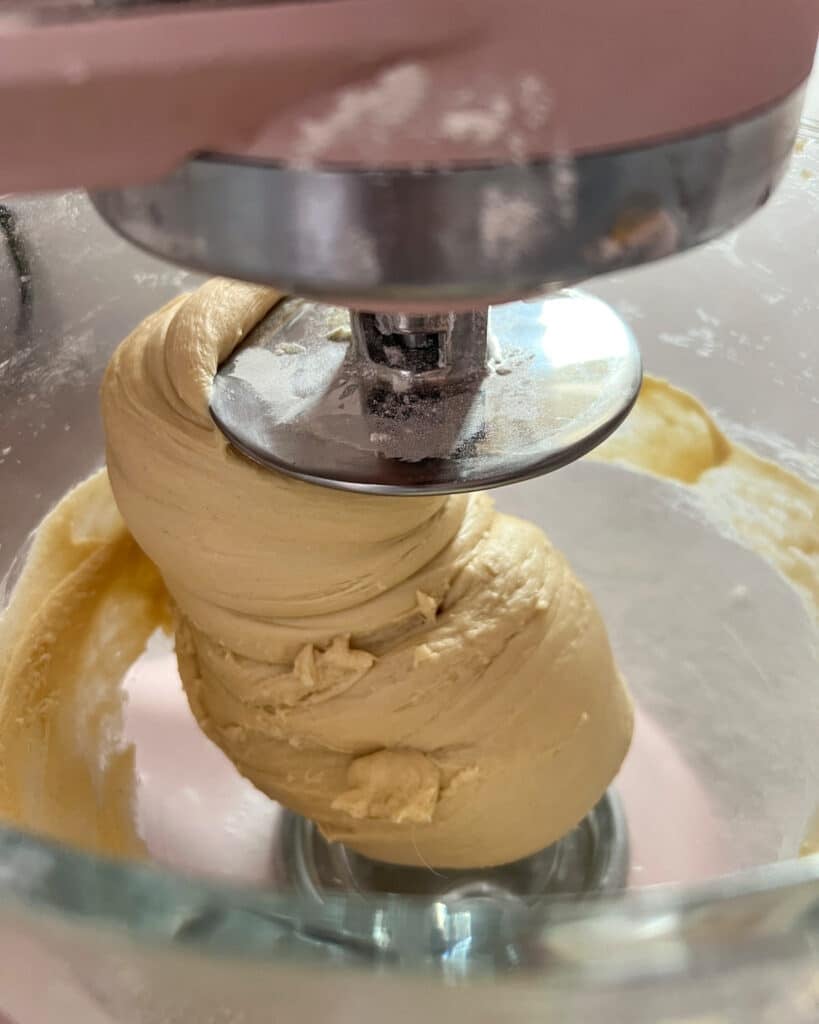
Knead the Dough
Turn the mixer up to medium-high speed for 3-5 minutes or until the dough is no longer sticking to the sides of the bowl.
If it seems too sticky, add an extra tablespoon of flour and keep mixing.
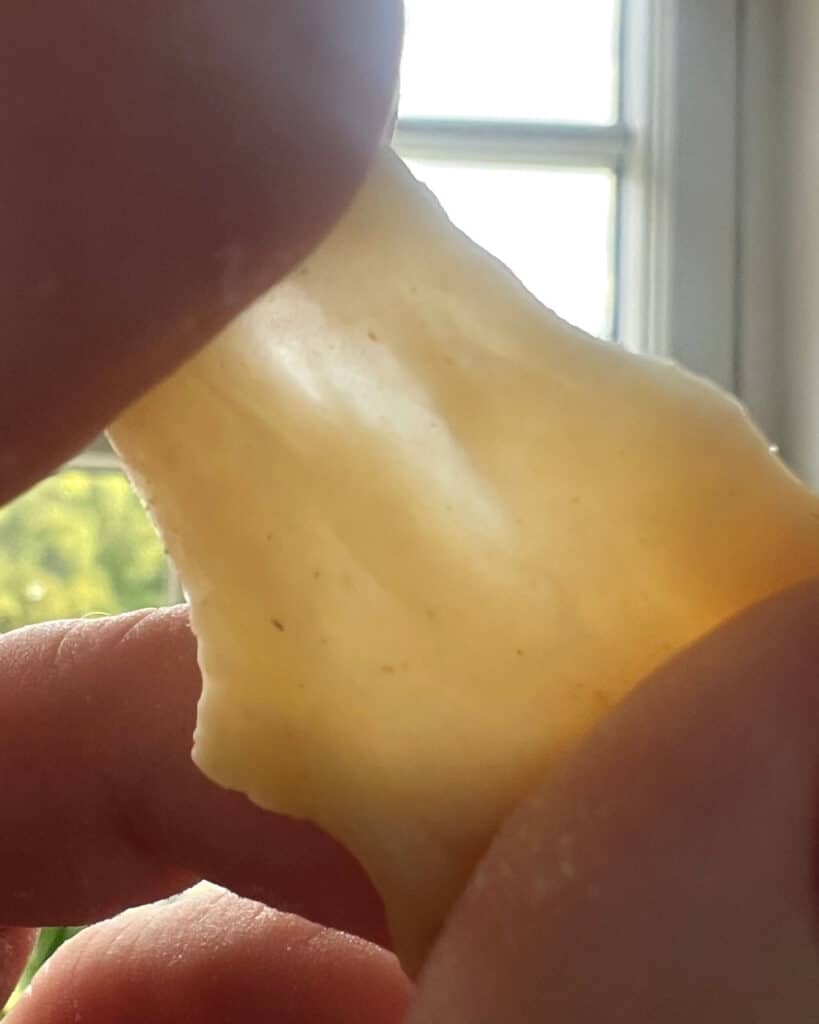
Windowpane Test
Tip the dough out onto a lightly floured work surface and knead by hand until it is no longer sticky.
Check if your dough is kneaded enough by doing the windowpane test. Take a small piece of dough and try to stretch it out. If you can stretch it enough to see light through it without it tearing, it's ready.
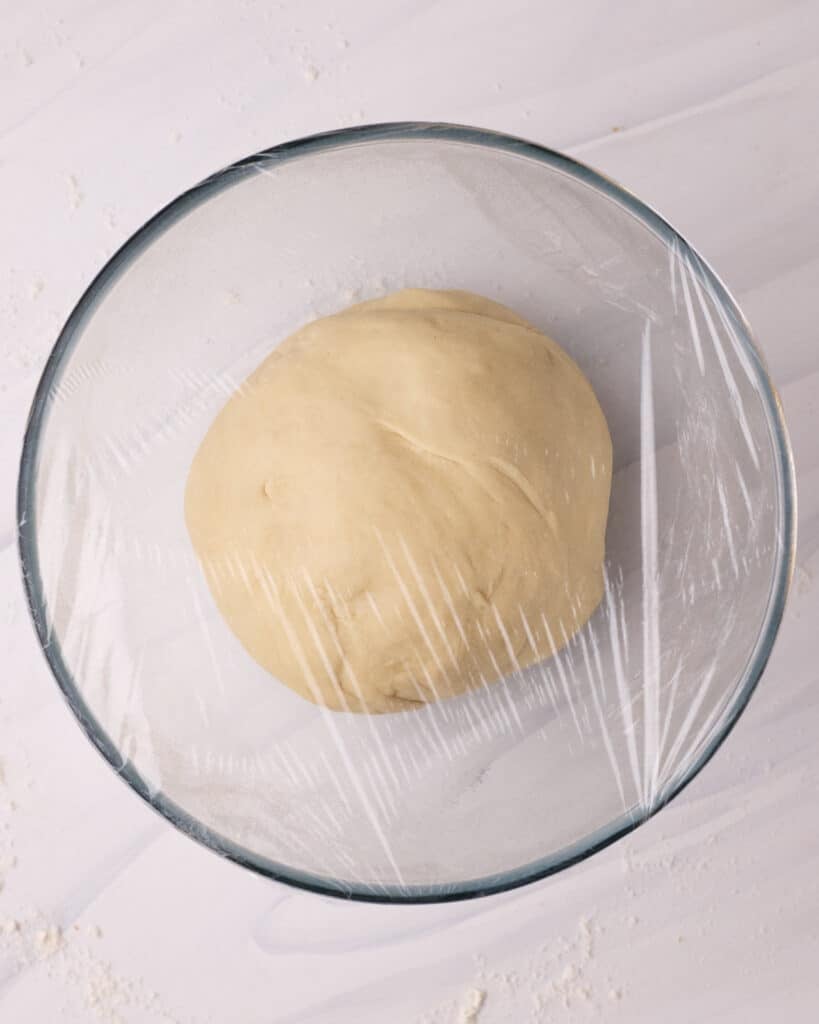
First Proof
Form the donut dough into a smooth ball and place it in an oiled bowl. Cover with plastic wrap and leave it on the countertop or in a warm spot to let the dough rise until it has doubled in size.
This first rise will take 1-2 hours depending on the temperature of your kitchen.
How to Test if Dough is Done Proving
Once your dough has doubled in size, you can test if it's ready by pressing on it with your finger.
Underproofed dough will bounce back immediately.
Perfectly Proofed dough will come back slowly, and only about halfway so you'll still see a small indent.
Overproofed dough won't spring back at all and may even deflate a little when you touch it.
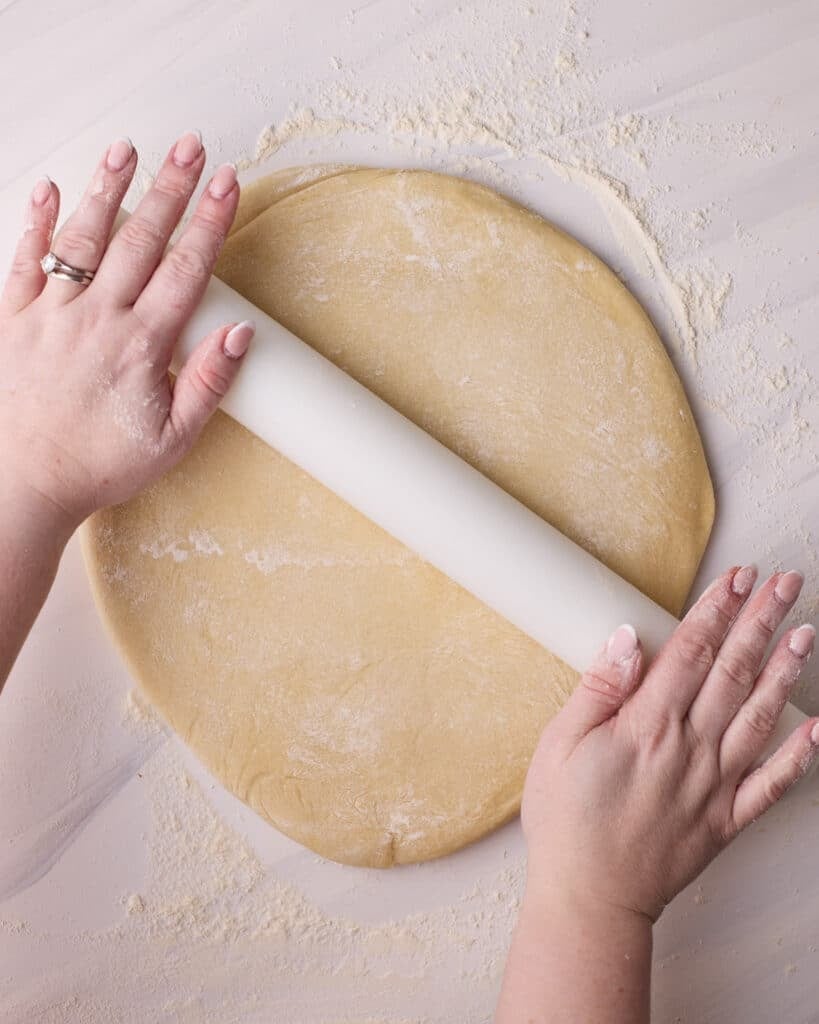
Roll Out the Dough
Once the dough is ready, punch it to release excess air, then tip it out onto a floured work surface and roll it to about ½ inch thickness.
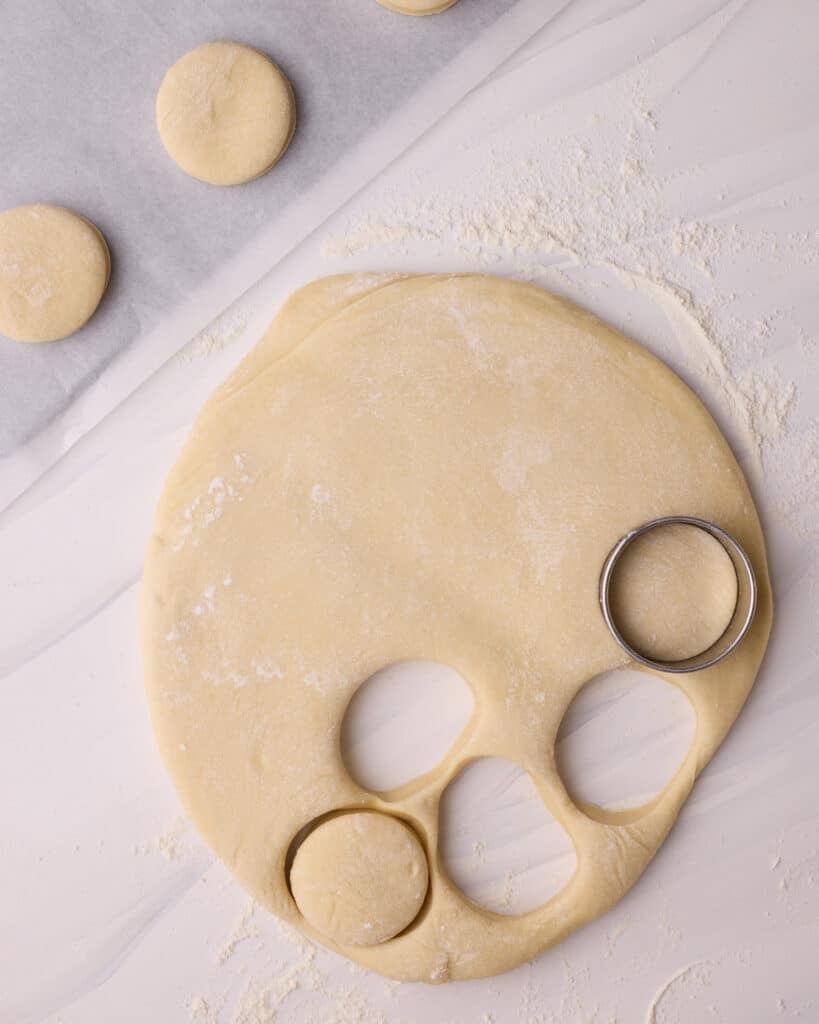
Cut Out the Donuts
Use a round cookie cutter (about 2 12 - 3 inches wide) to cut rounds out of the dough and place them on a lined baking sheet with a little space between them.
You can re-roll and cut out the scraps, but only once, so try to get your circles as close together as possible to use the dough efficiently.
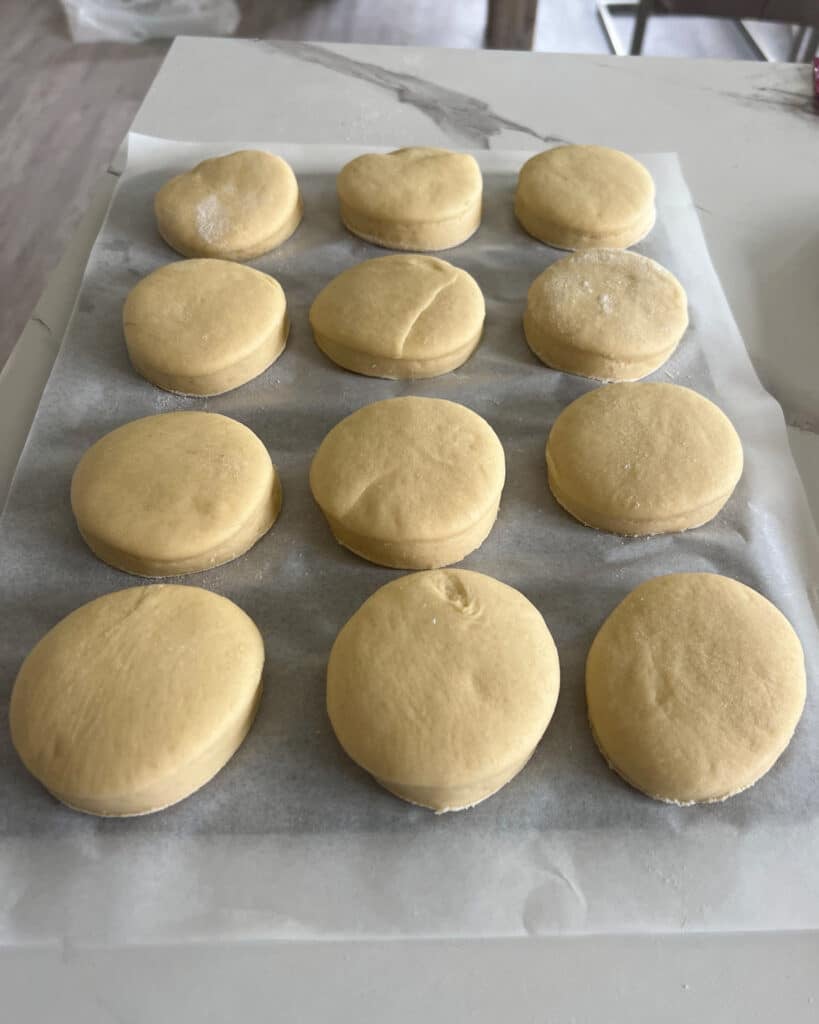
Second Proof
Cover the donuts loosely with plastic wrap or a kitchen towel and leave them to rise for a second time at room temperature for about 45 minutes.
You can do the finger prod test again here. If they aren't ready after 45 minutes check them every 10-15 minutes.
Once they are done, uncover them and start heating your oil in a medium saucepan. Make sure the oil is at least 2-3 inches deep.
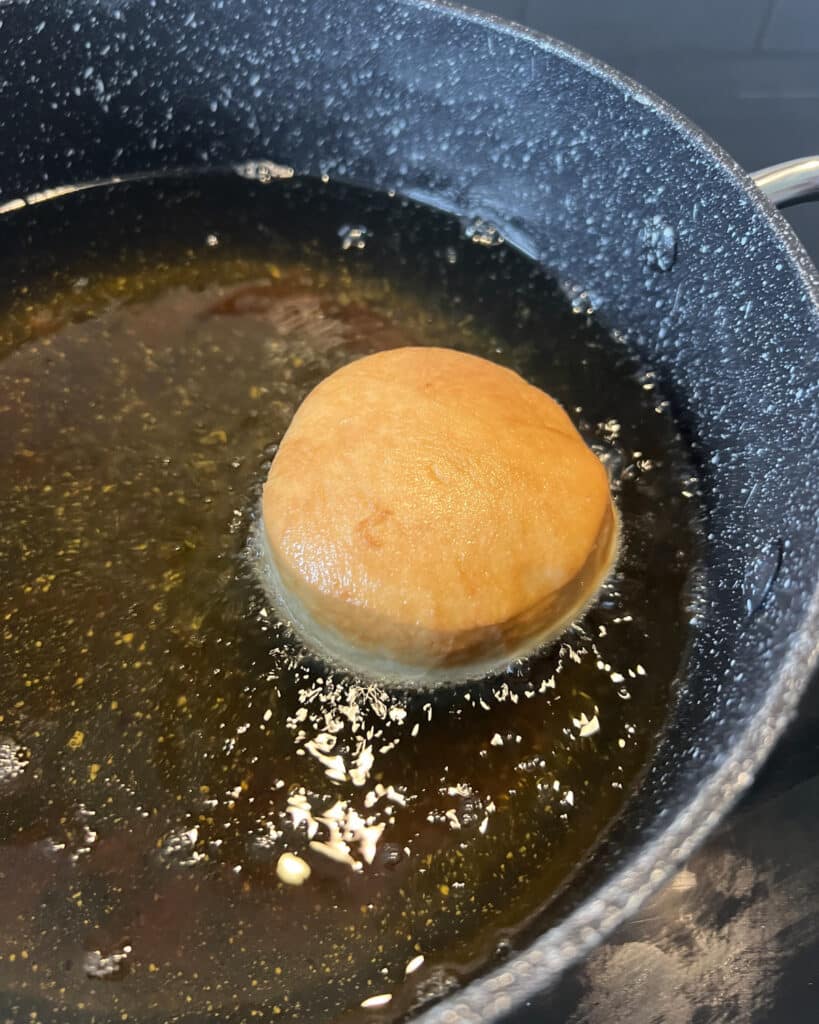
Fry the Donuts
Use a candy thermometer to gauge the temperature of the oil, it should be about 340°F (171°C).
Use a metal slotted spoon to lower your first donut into the hot oil, it should start bubbling immediately. Let it bubble until the underside is a light golden brown color (it will continue to brown after). Then flip the donut over and fry until the other side is the same color. Cook time should be about 1-2 minutes per side.
Remove from the oil and place on a wire rack lined with paper towels to absorb the excess oil. Repeat with all the donuts. I like to do this in small batches (2 or 3 at a time) to maintain control. Let the oil come back up to temperature in between batches.
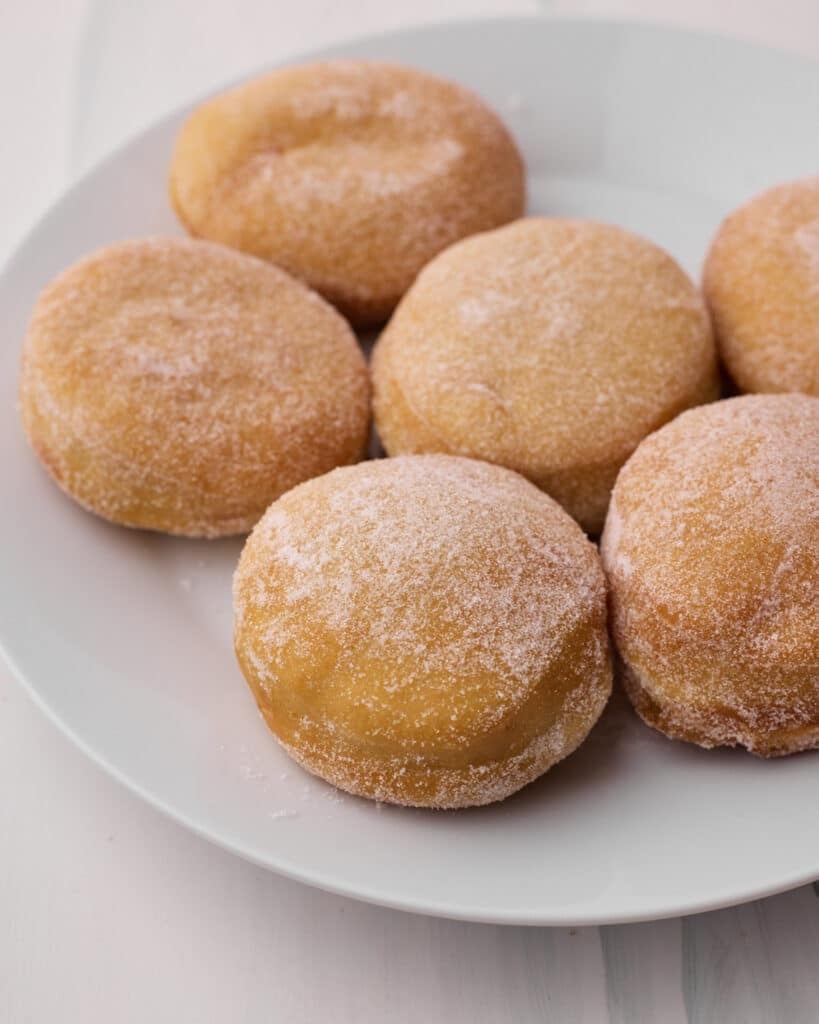
Sugar Coating
When the donuts are still hot but are cool enough to touch, roll them in a small bowl of sugar to coat entirely, then leave to cool completely.
You can roll them in granulated sugar or powdered sugar according to preference.
Tips for Frying Donuts
Maintain the temperature: The temperature of the oil is so important to the success of fried donuts! Many recipes will tell you to fry donuts at 375°F but I have tested this recipe at multiple different temperatures and the best results were always when the oil was maintained at a temperature between 325°F and 350°F.
Any hotter than this and the outside browns too quickly before the inside has had a chance to cook, and any lower and the donuts absorb too much oil. Use a thermometer to make sure the oil is within the right range, and let the oil come back up to temperature in between every batch as it will cool down when donuts are added.
Placement of thermometer: Make sure that your thermometer is suspended in the middle of the oil and not touching the bottom of the pan as this will give an inaccurate reading. Candy thermometers are designed to hold the bulb up off the bottom so they are fine, but if you are using a probe thermometer make sure you hold it in the middle of the oil and do not touch the pan.
Avoid finger indents: If you are leaving lots of finger indents in the donuts when transferring them to the oil, cut the parchment paper underneath them into little squares and use those to move them onto the spoon. Lower the spoon into the oil and hold onto the corner of the paper. The donut will slide off with no finger indents and you can discard the parchment paper.
Set up in advance: Frying with very hot oil can be stressful so I like to set up everything I need in advance to make the process go as smoothly as possible.
While the donuts are in their second proof, I set up my thermometer next to the pan as well as my cooling racks lined with paper towels, a bowl of sugar for rolling, and a plate next to the stovetop to rest my frying spoon on in between batches so I don't get the counter messy.
Having all this laid out in advance will save you from running around trying to grab things while fussing over a pot of extremely hot oil!
How to know when donuts are done: When you first add the donuts to the oil they will bubble and fizz quite a bit. Usually once this bubbling subsides it's a good indicator that they might be ready, gently lift one side of the donut to check the color. You are looking for a lightly toasted golden brown color - not super dark. They will also continue to brown a little after you take them out of the oil.
The time will vary depending on so many factors including your oil temp, the thickness of the dough, type of pan etc. Mine typically take about 1 minute and 15 seconds on the first side and about a minute on the second side. But just test out a few donuts one at a time until you find the perfect time for you.
How to Fill Donuts
Bavarian cream is a lighter version of pastry cream. It is similar to creme diplomat, which is what I use to make delicious cream-filled profiteroles.
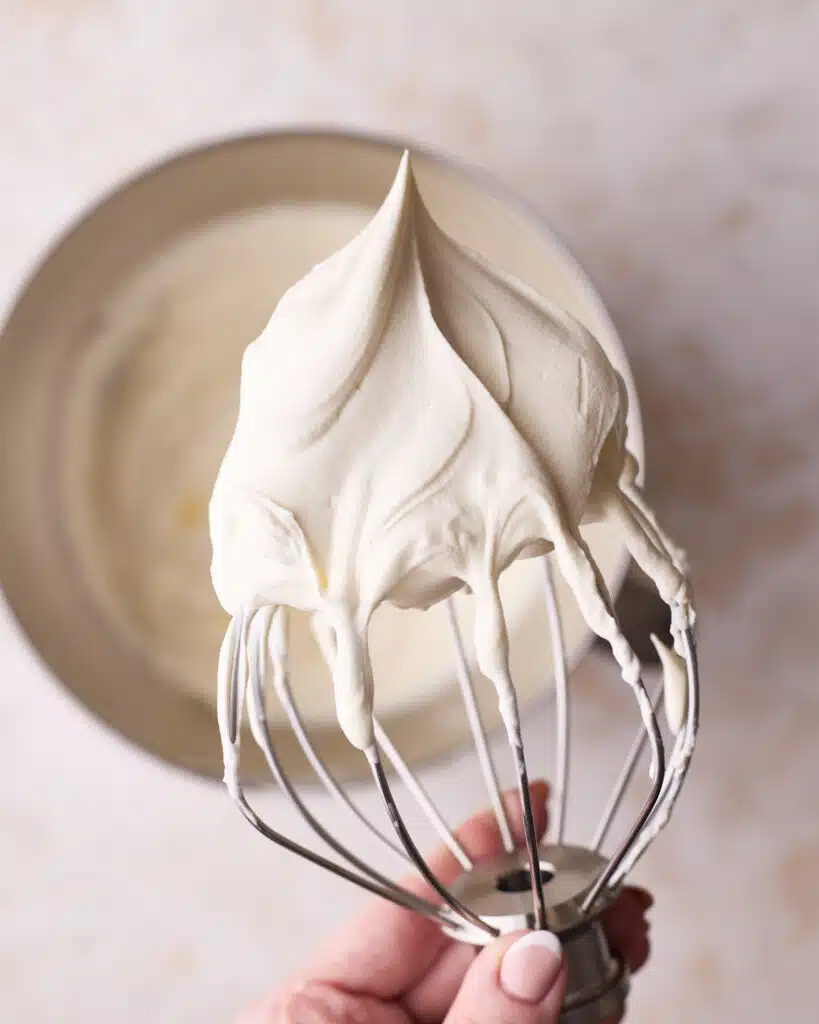
Whip the Cream
Whip up the cold heavy cream to stiff peaks. Don't overwhip it or it will be too stiff to fold in.
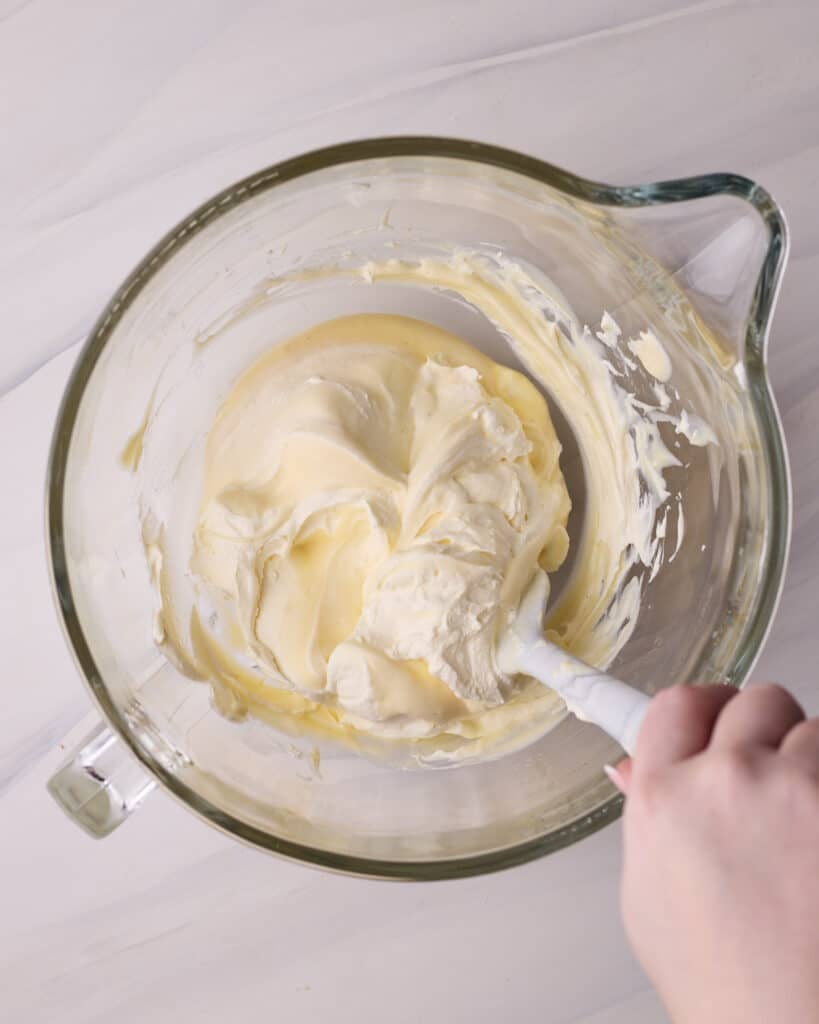
Fold the Filling
Remove the pastry cream you made earlier from the fridge and give it a mix to restore the texture.
Fold the whipped cream into the pastry cream in two batches. The first one will lighten the mixture and the second one will maintain more air.
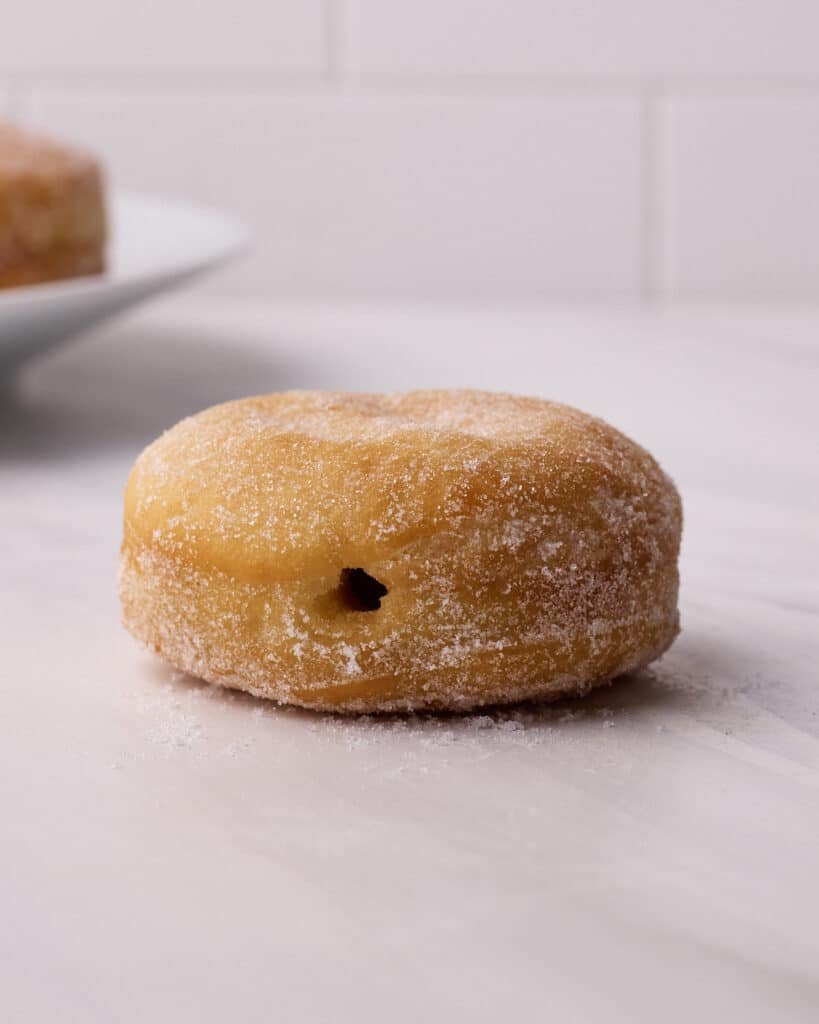
Poke a Hole
Use a long, thin object, like a metal straw or a chopstick, to poke a hole in the side of each donut and move it around inside to create space for the filling.
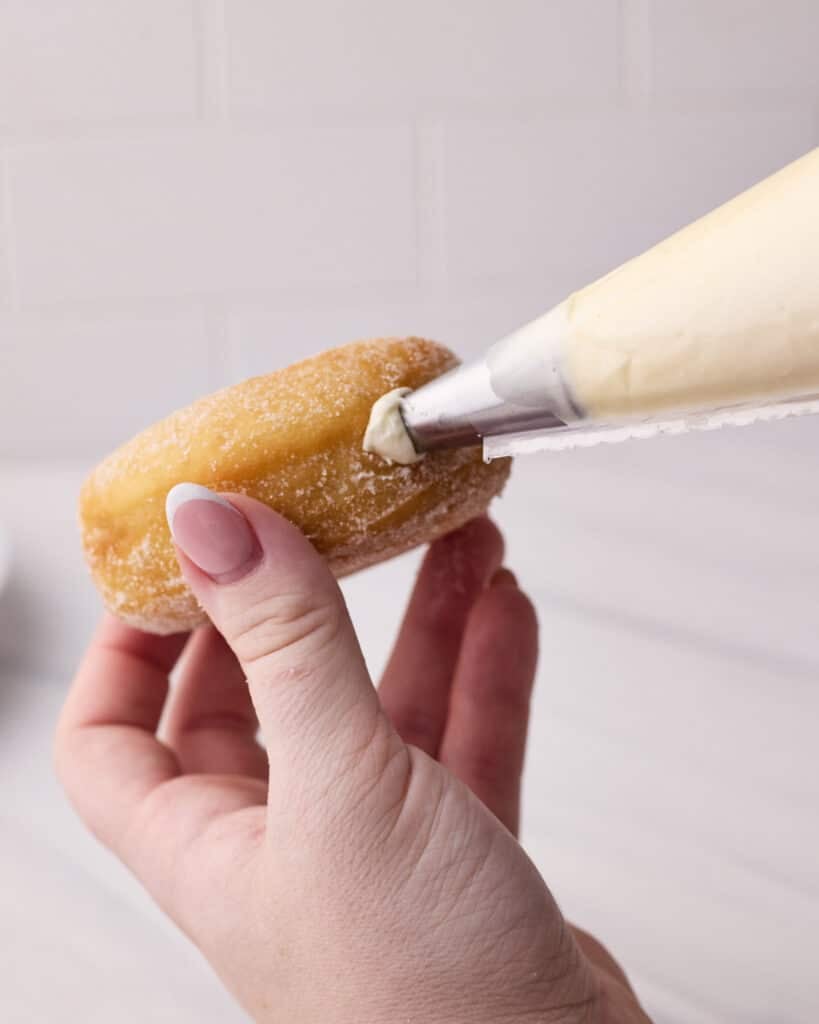
Fill the Donuts
Put the filling in a piping bag with any kind of nozzle and gently squeeze the Bavarian cream into the center of the doughnut until it starts to feel heavy.
Slowly pull the piping bag out of the donut, leaving a little blob of cream showing.
Troubleshooting Cream Filled Donuts
Yeast isn't frothing up: If your yeast mixture isn't frothing up then your yeast is likely dead and you'll need to buy more.
- Donuts are flat: If your donuts go flat on the second proof or during frying they were probably over-proofed. This can be caused by letting them rise too long or by leaving them in an environment that is too warm.
Some people put their dough into the oven at a low temp to proof, but this can lead to overproofing and then collapse. Yeast-based dough does like a bit of warmth to work, but if it's too warm it will take on too much air. Room temperature should be fine unless you live in a very hot climate. - Donuts are raw inside: This usually means that the oil was too hot so the outside of the donuts browned faster than the insides could cook.
- Donuts are dense: If your donuts are dense or don't puff up when fried, they were probably underproofed.
- Donuts are oily: If the donuts are super oily they were probably fried in oil that was not hot enough - as they are in the oil for longer they have more time to absorb more of the oil.
- Can't maintain oil temperature: If you are having trouble keeping the oil temperature steady, make sure you have it at medium heat or medium-low heat. It is also easier to maintain the oil temperature when you have more oil in the pan as shallow oil will fluctuate more.
It can take a while to find the right heat setting that will gently keep the oil hot without it going up and down like crazy. The oil will cool down each time you put donuts in there so if you can get it just gradually rising then you should be able to get into a good flow.
Every stovetop is different and you'll get to know what works best for you. - Something else? Did you have an issue with your donuts that isn't covered here? Let me know in the comments and I'll try to help you troubleshoot it!
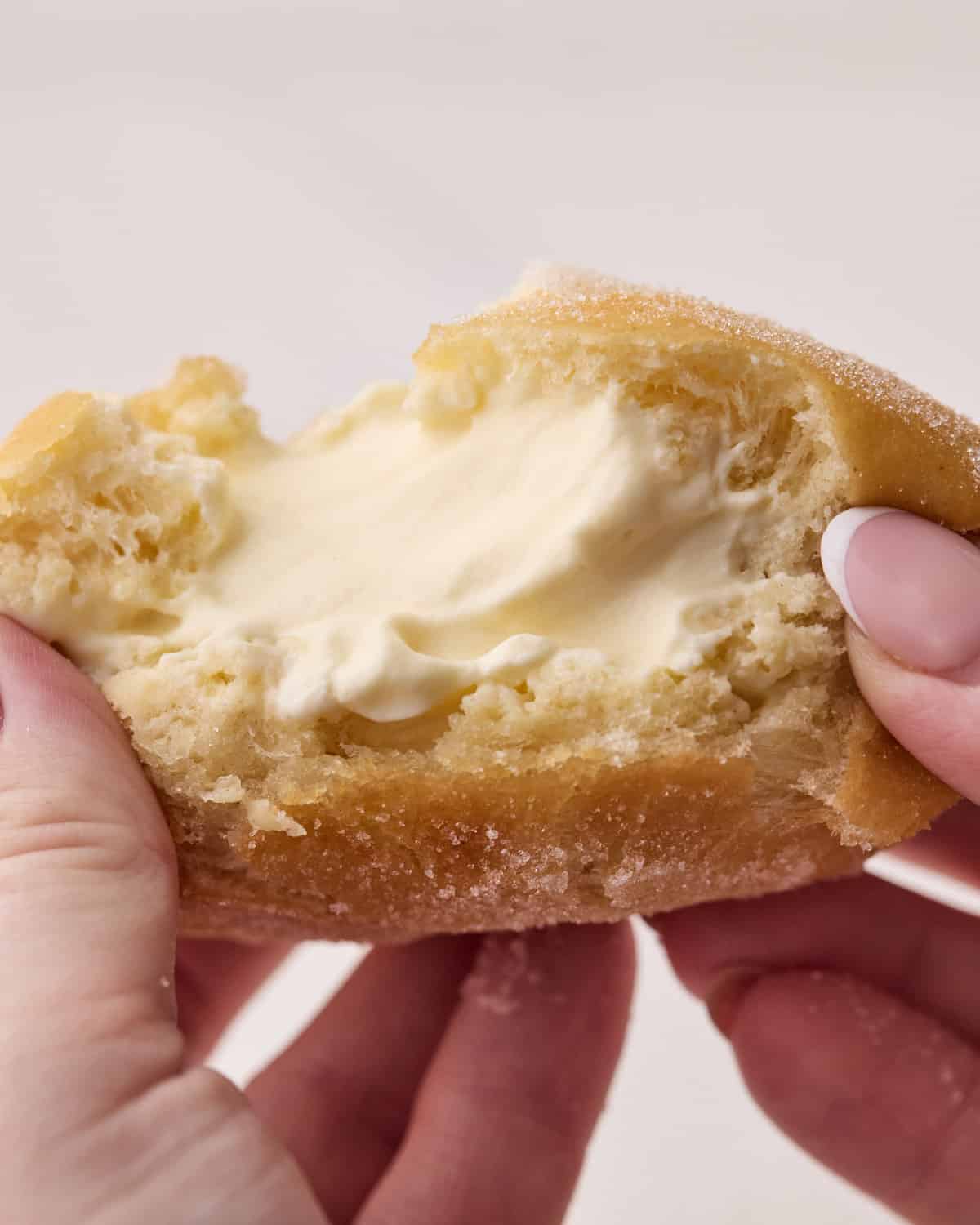
Bavarian Filled Donut Variations
Different flavors - While the creamy vanilla filling is super tasty, it's so easy to adjust this recipe to make a variety of different flavors. Try using my pistachio pastry cream instead of vanilla, or you could add Nutella or peanut butter for Bavarian donuts with a twist.
Cinnamon Sugar - Add a tablespoon of cinnamon to the bowl of sugar before you roll the donuts in them for a delicious cinnamon sugar flavor.
Add a glaze - For an extra touch of sweetness, add a glaze to the top of these donuts, like a chocolate glaze or coffee glaze. Check out my Mini Bundt Cake post for inspiration on different flavored glazes.
Boston Cream Donuts - With just a few small tweaks to this recipe you can make Boston Cream Donuts as well. You could even make both kinds of donut from the same batch. Check out my Homemade Boston Cream Donut recipe for details.
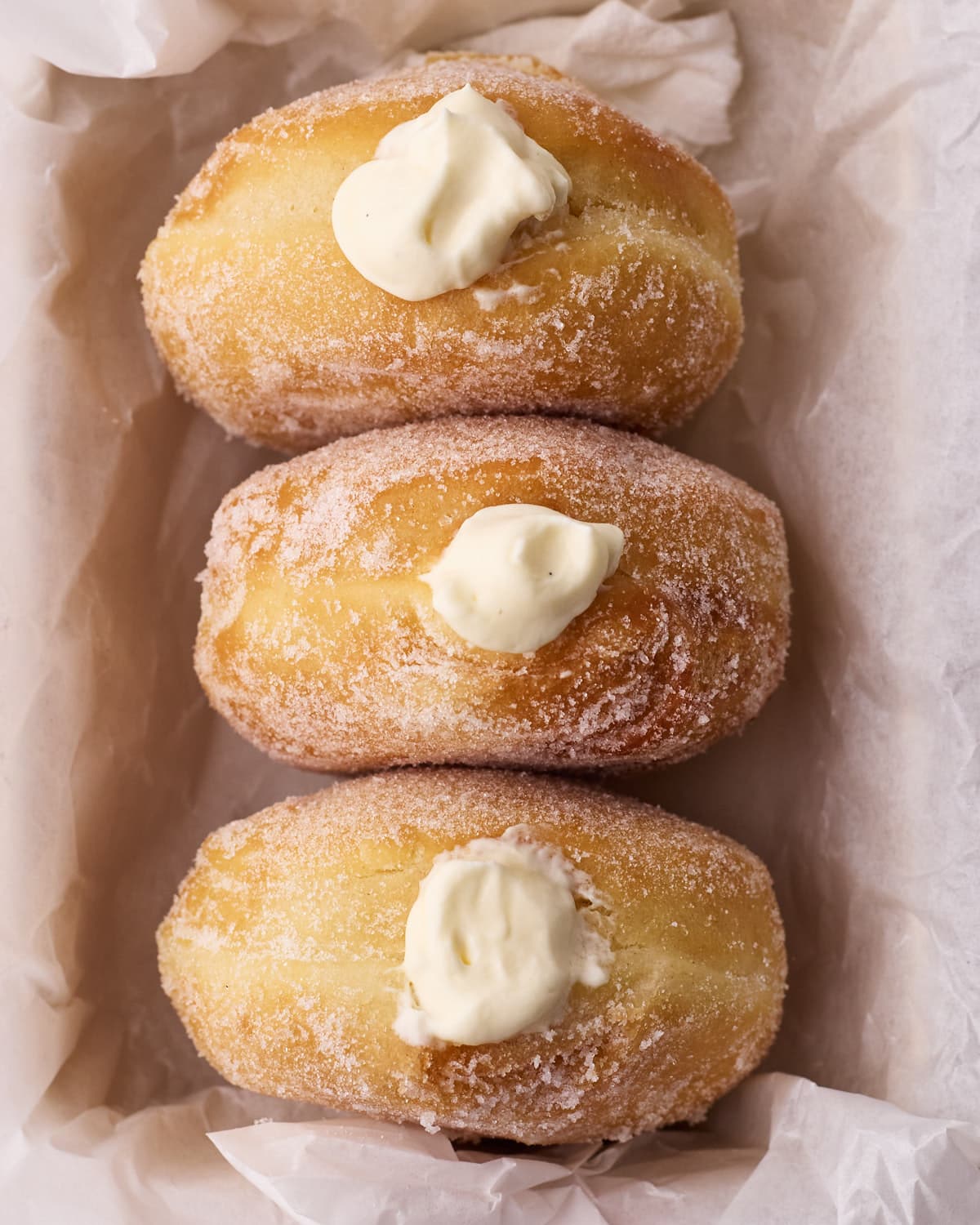
Storage
I strongly recommend making these donuts the day you plan to eat them, they just aren't as good the next day.
You can make the donut dough the night before by using the overnight proofing. method (see FAQ section). And the pastry cream can be made up to 72 hours in advance and stored in the fridge.
If you do have leftovers, store unfilled donuts in an airtight container with paper towels. or in a paper bag.
Any donuts already filled with Bavarian cream will need to be stored in the refrigerator in an airtight container. Eat as soon as possible!
FAQ
Bavarian cream (or crème Bavaroise) is actually a set dessert made from crème anglaise (custard sauce), whipped cream, and gelatin.
But the delicious creamy filling you know that is typically in Bavarian cream donuts is made from pastry cream and whipped cream folded together.
Bavarian cream donuts are rolled in sugar and filled with a mixture of pastry cream and whipped cream.
Boston cream donuts are not coated in sugar, are filled with straight pastry cream, and are topped with a chocolate glaze.
Bavarian cream is classically made with creme anglaise (runny custard) and gelatin, whereas creme diplomat is creme patissier (pastry cream) folded together with whipped cream.
So technically speaking, these donuts are filled with creme diplomat, but this is the tasty Bavarian cream filling you know and love.
Yes! I have an induction stovetop and had no problems frying these donuts. Actually the way an induction stovetop provides heat can even make it easier to control the temperature of the oil.
This recipe can be made with either active dry yeast or instant yeast.
If you use instant yeast there is no need to activate the yeast in warm milk first, you can just add it straight into your bowl with the wet ingredients.
Honestly, fried donuts are usually best enjoyed fresh. They would still be safe to eat the next day but they will have lost some of the lovely fluffy texture and won't taste as good.
You can make the filling in advance though and use the overnight proofing method for the donut dough (see below).
If you prefer, you can actually do the first proof overnight in the fridge.
The cold temperature slows down the fermenting process of the yeast and allows the dough to rise slowly, so you still get a lovely fluffy donut dough but over a longer period of time.
To do this, after you have placed your dough in the oiled bowl and covered it, put it straight in the fridge for 8-10 hours.
When you are ready to shape your donuts the next day, let the bowl sit on the counter for about 40 minutes to warm up a little bit before you roll it out.
The butter is added last to allow the flour to properly hydrate with the milk. If you add the butter at the same time it can stop the flour from soaking up enough moisture.
More Custard Desserts
If you love these Bavarian cream donuts, you might enjoy some of these other custard recipes:
Recipe
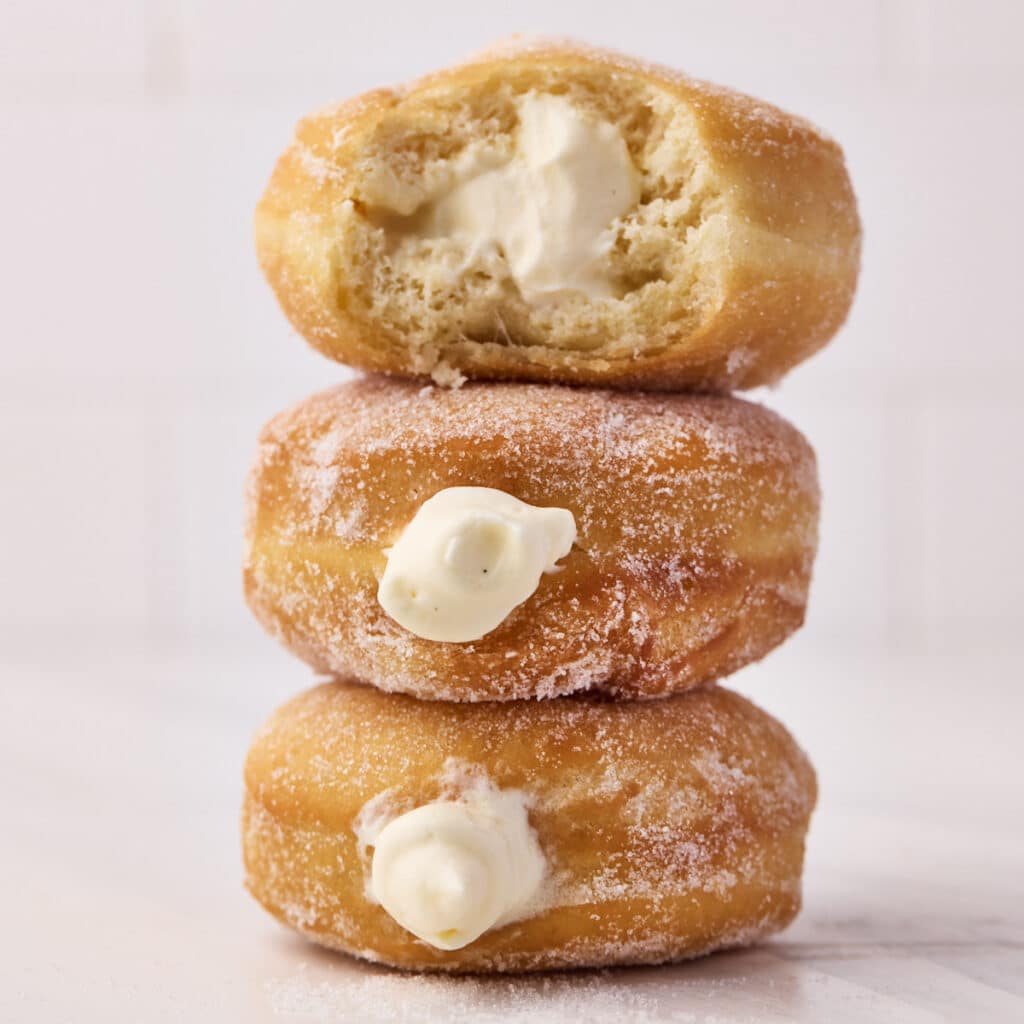
Bavarian Filled Donut
Ingredients
- 3 Large Egg Yolks
- ¼ cup Granulated Sugar 50g
- 1 cup Whole Milk 240ml
- 2 tablespoon Cornstarch
- 1 teaspoon Vanilla Extract
- ⅓ stick Unsalted Butter 38g
- 1 cup Heavy Cream 240ml
- 5 cups All-purpose Flour 600g
- ½ cup Granulated Sugar 100g (plus extra for coating)
- 2 packs Active Dry Yeast 14g (or instant yeast*)
- 1 cup Whole Milk 240ml
- 2 Large Eggs
- ⅔ stick Unsalted Butter 80g (melted)
- 1 teaspoon Salt
- Vegetable Oil for frying
Equipment
- Medium Saucepan
- Stand Mixer with dough hook attachment
- Round Cookie Cutter 21/2 - 3 inches wide
Instructions
- For the filling make a pastry cream ahead of time, at least two hours before it is needed. For in-depth instructions and step-by-step process shots of how to make pastry cream, check out my pastry cream recipe post. (Note that this Bavarian cream filling only requires half a batch of this pastry cream recipe, as reflected in the ingredients section above).
- Whisk the egg yolks together with the cornstarch and 2 tablespoons of the sugar.3 Large (3) Egg Yolks, 2 tablespoon Cornstarch
- Pour the remaining sugar into a saucepan along with the milk and vanilla. Heat over medium-low heat.¼ cup (50 g) Granulated Sugar, 1 cup (240 ml) Whole Milk, 1 teaspoon Vanilla Extract
- Once the milk begins to feel warm, drizzle it slowly into the egg yolk mixture, whisking it in to combine as you go. It's important to do this gradually to slowly bring up the temperature of the egg yolks.
- Once all the milk has been added, pour the whole mixture back into the saucepan and continue to cook, stirring gently but constantly until the pastry cream begins to thicken.
- Bring the custard to a boil. Once you see thick bubbles bursting on the surface of the cream, boil for one minute (whisking the whole time).
- Remove from the heat. If you have warmed it slowly then there shouldn't be any lumps in the pastry cream, but if you do have some lumps, pass the pastry cream through a fine mesh sieve to remove them.
- Whisk in the butter, one tablespoon at a time, making sure it is completely incorporated before adding the next.⅓ stick (38 g) Unsalted Butter
- Cover with plastic wrap, so the plastic is touching the surface of the pastry cream, and let cool. Then refrigerate until needed.
- Warm the milk to roughly body temperature and mix in the active dry yeast and 1 tablespoon of the sugar. Let it sit for 5-10 minutes or until it starts to froth up.If you are using instant yeast you can skip this step.1 cup (240 ml) Whole Milk, 2 packs Active Dry Yeast
- In the bowl of a stand mixer with a dough hook attachment, add the remaining sugar, salt, and eggs.½ cup (100 g) Granulated Sugar, 2 Large (2) Eggs, 1 teaspoon Salt
- Once the yeast is frothy, pour the milk/yeast mixture into the mixer bowl and stir everything together to combine.
- Add the flour and turn the mixer on low speed for 1 minute until it incorporates slightly.5 cups (600 g) All-purpose Flour
- With the mixer still on low speed, slowly drizzle in the melted butter.⅔ stick (80 g) Unsalted Butter
- Turn the mixer up to high speed and let it mix for 3-5 minutes or until the dough is no longer sticking to the side of the bowl.
- Tip the dough out onto a lightly floured work surface and knead it by hand until it is no longer sticking to your hands.
- Form the dough into a smooth ball and place it in an oiled bowl. Cover with plastic wrap and leave it on the countertop to rise until it has doubled in size ( 1-2 hours depending on the temperature of your kitchen.
- Once the dough has doubled in size, check if it is ready by pressing on it lightly with your finger. If the indent disappears immediately, it needs longer to prove. If the indent comes back slowly and only about halfway, then it is ready to use.
- Punch the dough to release the excess air then tip it onto a floured work surface and roll it out to ½ an inch thick.
- Use a round cookie cutter (2 ½ - 3 inches wise) to cut rounds out of the dough and place them on a lined baking sheet, with a little space between them. You can re-roll and cut out the scraps, but only once.
- Cover the donuts loosely with plastic wrap or a kitchen towel and leave to prove again for roughly 45 minutes. Do the indent test again to see if they are ready and if not, leave them for another 15 minutes.
- Once the donuts are ready, uncover them and start heating up the oil. Make sure the oil in your pan is at least 2-3 inches deep.Vegetable Oil
- Using a candy thermometer, bring the oil to a temperature of 350°F / 180°C.
- Next to your stovetop, set up a wire rack lined with paper towels (this is to absorb the excess oil).
- Test out your first donut by lowering it gently into the oil with a metal slotted spoon. It should start to bubble around the edges.
- Fry the donut until it is a pale golden brown color (it will continue to brown after). Then flip the donut over and fry the other side until it is the same color. This should take about 1-2 minutes per side.
- I find the optimum temperature for frying these donuts is 325° - 340°F ( 165° - 171°C). Make sure you let the oil come back up to temperature in between donuts as it may cool down as you are frying.
- Remove the donut from the oil and place on the wire rack lined with paper towels. Let cool for a minute or two then roll in sugar.
- Repeat with all the donuts, I don't recommend doing more than 2 or 3 at a time as they do fry so quickly.
- Once the donuts have completely cooled, you can fill them. Whip the heavy cream up to stiff peaks and fold it into the pastry cream. Fold in half the cream first to lighten the mixture, then fold in the second half1 cup (240 ml) Heavy Cream
- Use a long thin object like a chopstick or a metal straw to poke a hole in the side of each donut and move it around to create space in the middle.
- Put the filling into a piping bag with any kind of nozzle and squeeze it into the donuts. Once the donut feels heavy you will know it is full.

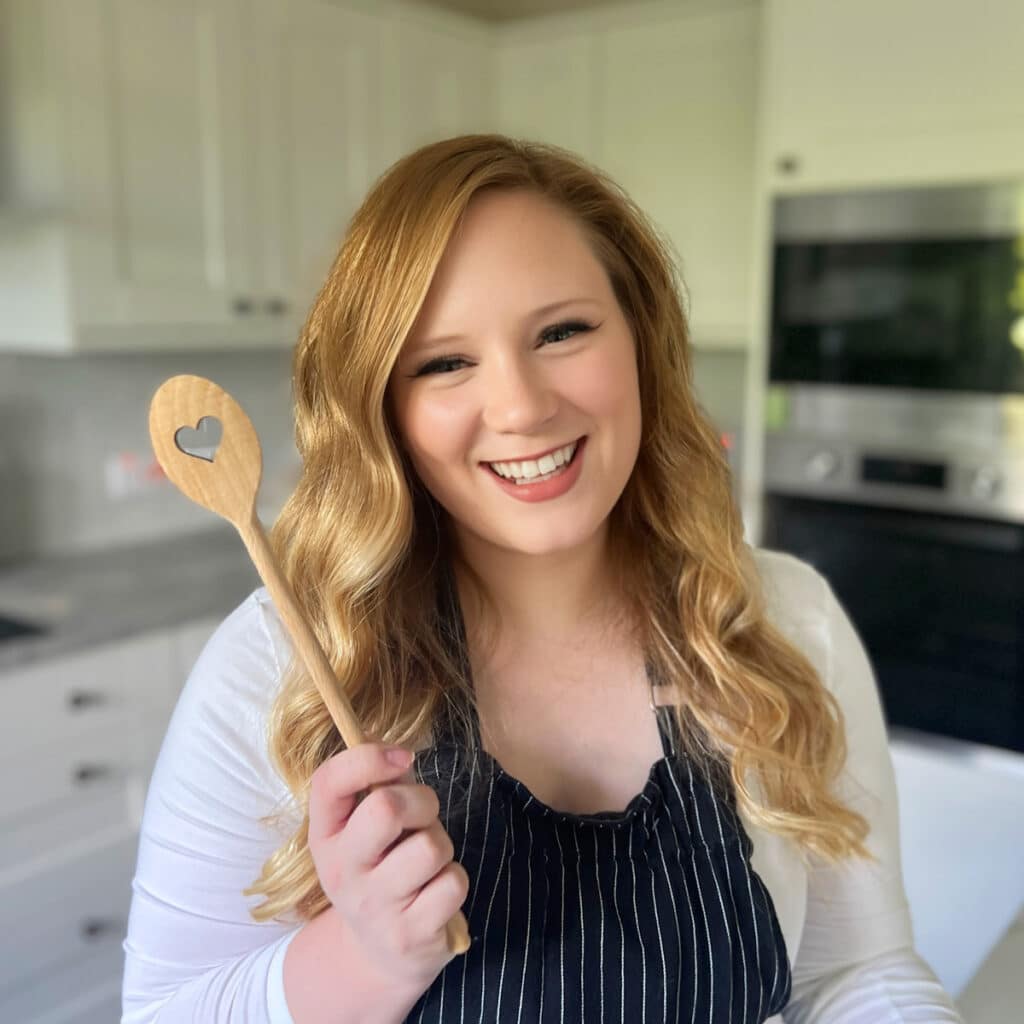
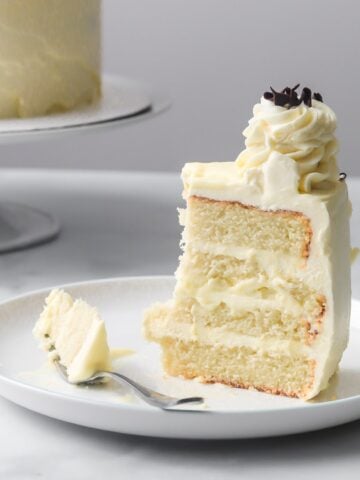

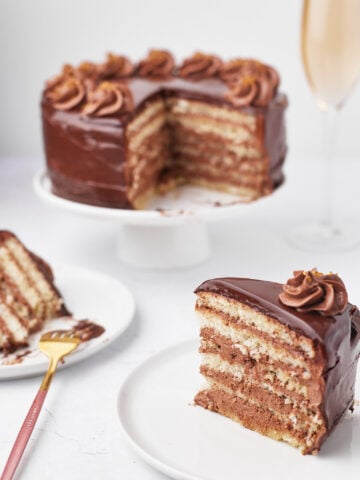
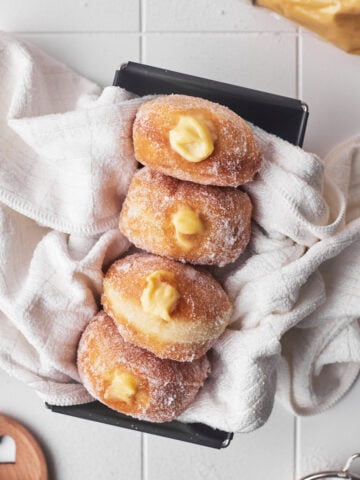











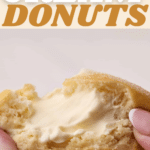




Nicole Jackson
Am I the only one that noticed that the ingredients for the Bavarian cream call for 1cup of whole milk and 1cup of heavy cream but the heavy cream is never added in? The directions never state when to add it and only list the milk and vanilla was being added. Not wanting to ruin it completely I didn’t add. This is more like a Boston cream than a Bavarian. It’s good but not what I was looking for.
Jules Grasekamp
Hi Nicole,
The cream is whipped and folded into the pastry cream, right before filling the donuts. You can see this both in the 'Fill the Donuts' section in the recipe card and in the step-by-step instructions in the post. There is even a picture of the cream being whipped and folded into the custard 🙂
Also the post addresses the fact that 'Bavarian Cream' is actually a different kind of dessert, but the popular 'Bavarian Cream Donuts' that everyone knows and loves are filled with a filling like this, which is closer to a creme diplomat. I hope this helps 🙂
Nicole Jackson
Thank you, I read and re-read those directions looking for it, but I did not read about how to fill the doughnuts because I know how to do that already. It might be good to note earlier in the directions that the cream will be folded in later.
Sonnet Adcox
Is the dough supposed to be tough
Jules Grasekamp
Hi Sonnet,
No the dough shouldn't be tough - at what stage did it get like this? I can try to help you troubleshoot!
Jules
Sonnet Adcox
It got tough after I had put it in a bowl with Saran wrap over top of it and let it double in size and then when I went to do the test it was good so I took it out to roll it and use the cookie cutter to cut out the donuts and let them rise again but it was too tough to use the cookie cutters
Chris Radwanski
What can I tell you, other than these are the most fluffy amazing donuts I have EVER had the pleasure of eating. I sat down, ate one, then two, then three and after my fourth one, I decided that was enough. I had to stop myself honestly.. Delicious!